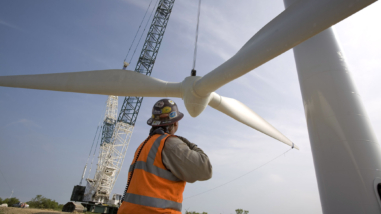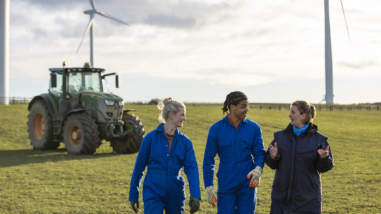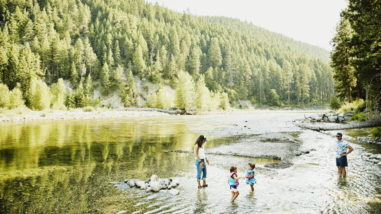We can rise to today’s challenges

On this 50th anniversary of the first Earth Day, we are all in an unsettled place. Globally, the COVID-19 pandemic has taken tens of thousands of lives and containment measures have caused unprecedented economic disruption. Our world has turned upside down.
Beyond the pandemic disaster, other dangers — most notably the very real threat and current impacts of climate change — are looming. Here in California, scientists say that amidst one of the driest 20-year periods in this state’s history we have entered a climate-driven megadrought. 2019 was the warmest year on record for the world’s oceans, affecting marine life in grave ways, and the large populations and many industries here in the U.S. and worldwide reliant on fishing – and already, water temperatures in parts of the Atlantic, Pacific and Indian Oceans, as well as in the Gulf of Mexico, are exceeding the 2019 levels. We can anticipate more severe superstorms, hurricanes and cyclones – and these could hit places already reeling from COVID19 pandemic suffering and response.
Since climate change won’t stop for the coronavirus pandemic, and climate associated natural disasters could double the jeopardy to both our people and our economy, we must address both.
This may feel daunting, but if we look over the past 50 years at the progress that has been made on many huge environmental issues — dirty air and polluted water foremost among them — we should realize that we are capable of coming together to act in the face even of multiple crises. Major environmental programs enacted in the 1970s made lasting, durable and measurable differences. In 1970, to address unprecedented and crisis levels of air pollution and smog in America’s major cities, Congress passed the Clean Air Act, an ambitious revamping of the federal government’s role in cleaning up air pollution. That act was bipartisan – and helped pave the way for a host of subsequent legislative and regulatory actions, that have saved countless lives and helped safeguard the environment that we all depend on.
This happened at a time when, as now, the US was roiled with political disagreements and civil strife, deep into years of casualties with the Vietnam War and in the midst of a great struggle for social change, with a wave of civil rights laws and a backlash of sustained violence against African Americans.
None of this was easy, and it should provide inspiration for the road that lies ahead. Then, as now, we had to surmount opposition from entrenched interests, overcome uncertainty in the science, and in many cases, develop entirely new bodies of law and policy, and the institutions to implement them, and above all, make our voices heard. On this day in 1970, 20 million Americans – an estimated extraordinary 10 percent of the population — took to the streets to protest extreme industrial pollution and demand regulation. By the end of that year, the Environmental Protection Agency was created, and the Clean Air Act was passed. And in the next three years the Clean Water Act, the Endangered Species Act, and the Federal Insecticide, Fungicide, and Rodenticide Act (FIFRA) were passed to protect humans and species from toxic and industrial waste, development, and other human impacts on lands and waters. That history should allow us to face this moment with some degree of confidence in our ability to manage the current changes we need to make.
Today, unlike then, technology is on our side, with a raft of advances, including in renewable energy, battery capacity, electric vehicles and energy efficiency, that will ease our transition to a more sustainable future. It will likely be cheaper, even without the extraordinary benefits that will accrue from saving the climate, to make these changes than to stick with the status quo.
Climate change isn’t the only environmental problem we need to be working on, of course. The earth is witnessing a massive loss of biodiversity. Plastics are polluting every inch of the ocean. Forests and global biodiversity are increasingly at risk.
These are complicated, daunting planetary problems that will require new levels of coordination, communication and cooperation – and certainly, much greater levels of philanthropic investment. But we have the ability to overcome the hurdles and develop genuine, equitable, lasting solutions. We have frameworks for global collaboration. And we have a new generation of educated, engaged and informed youth who understand the risks these damages pose to them and who are committed not only to action themselves but to exerting political pressure where we need it to ensure the governments of the world take the steps necessary to avert the worst of this disaster.
As we recover from this pandemic — and we will recover — we will be faced with both challenges and opportunities. Governments will be making massive investments to restart the economy. Those investments must be made wisely. This once-in-a-century disaster will give us a once-in-a-century opportunity to not just rebuild our economy but reimagine the kind of world we want to live in.
But we can also do it wrong. Governments can spend their money not to transform the world to a better and cleaner version – the one we and our children really want to live in – but to prop up the old, dirty, status quo. One where polluting industries have all too free rein to despoil the environment with hardly any consequence, perpetuate environmental inequities, and where governments enable that behavior rather than steer us to a more sustainable path.
The choice is up to us. We can do this. We can come back stronger and better. We can build the world we want to live in. But we don’t have much time. Decisions are being made today – and unfortunately, the environment won’t give us a second chance.



